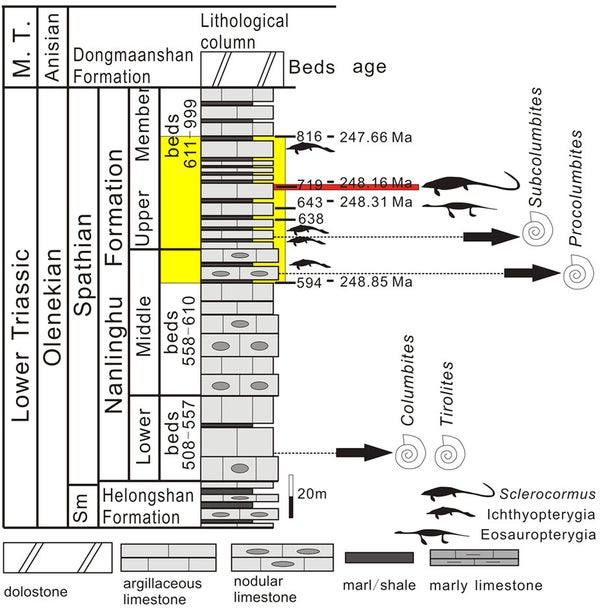This article was published in Scientific American’s former blog network and reflects the views of the author, not necessarily those of Scientific American
There are upsides to being extinct. You're not around to feel embarassed when paleontologists excavate your remains and deem you "aberrant", for example, as just happened with a 248-million-year-old marine reptile.
Weirdness is all relative, and, in fossil circles, what's found first often sets the trend for what's "normal." Through that lens, Sclerocormus parviceps truly is something unusual. Found in the earliest Triassic rocks of Anhui Province, China, this ocean-dwelling reptile appears to be one of the earliest members of a very famous and storied group - the ichthyosaurs. The more familiar members of this family look like reptilian versions of sharks - streamlined bodies and half-moon tail flukes, albeit with elongated snouts filled with conical teeth - but Sclerocormus lived long before this body plan became standard. Instead, this newly-named marine reptile represents an early burst of evolutionary novelty in the wake of the world's worst extinction crisis.
Described by paleontologist Da-Yong Jiang and colleagues, Sclerocormus is the embodiment of ichthyosaur extremes. The animal's skull is short and stubby while a long, flukeless tail trails behind its body. The only other ichthyosaur like this is another recent find, Cartorhynchus, that lived around the same time and helps connect the ocean-dwelling saurians with their terrestrial ancestry.

Strat column showing when Sclerocormus lived. From Jiang et al., 2016.
Sclerocormus is more than unusual fossil face, though. The early ichthyosaur helps outline the boom and bust history of reptiles that returned to the sea. In the past, Jiang and coauthors write, paleontologists thought that marine reptiles were relatively slow to slip into the sea following the mass extinction that stripped the seas of most life around 252 million years ago. The existence of Sclerocormus - as well as many other marine reptiles - by 248 million years ago is a sign of rapid recovery from that disaster.
Yet the story isn't as simple as ichthyosaurs and other scaly creatures entering the seas and spreading into the available aquatic habitats. There was no "single phase of unbroken increase in diversity", the researchers write, but rather pulses in evolution and extinction. Sclerocormus, Cartorhynchus, and other ichthyosaurs were early adopters of a seagoing lifestyle, but something happened to them. Their diversity crashed and went through a bottleneck, after which other marine reptiles - like the earliest plesiosaurs - proliferated. While some ichthyosaurs survived, the early and "aberrant" ones disappeared. Look at Sclerocormus one way, then, and you'll see the resiliency of life in the face of extinction. Look at it another, and you'll see evolutionary possibilities snuffed out soon after they sparked into existence.
On supporting science journalism
If you're enjoying this article, consider supporting our award-winning journalism by subscribing. By purchasing a subscription you are helping to ensure the future of impactful stories about the discoveries and ideas shaping our world today.
Reference:
Jiang, D., Motani, R., Huang, J., Tintori, A., Hu, Y., Rieppel, O., Fraser, N., Kelley, N., Fu, W., Zhang, R. 2016. A large aberrant stem ichthyosauriform indicating early rise and demise of ichthyosauromorphs in the wake of the end-Permian extinction. Scientific Reports. doi: 10.1038/srep26232